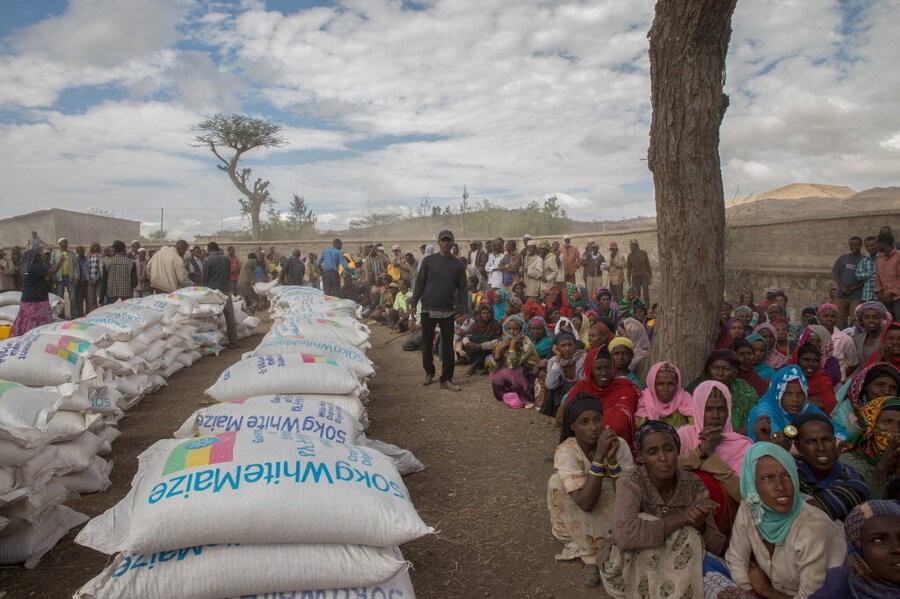Why is nobody talking about Africa's drought?
Loading...
| Johannesburg, South Africa
Since late 2015, Southern and Eastern Africa have been hit hard, and scientists warn that human-aided climate change is likely to make such events more frequent. The good news: While Africa needs help, it’s now more able to help itself.
Q: How did this drought come about?
El Niños happen frequently – on average every three to five years – and tend to flip-flop normal global weather patterns, drenching much of the Northern Hemisphere and causing lower-than-average rainfall in much of the Southern. (It is far more complex than that, but those are the general patterns.) The El Niño that struck at the end of 2015 was the strongest in nearly two decades and severely delayed rains in both Southern and Eastern Africa, causing immediate crop failure, livestock deaths, and widespread water shortages.
Q: What does it tell us about how climate change is affecting Africa?
Although it is difficult to prove a direct link between climate change and a strong El Niño, scientists say the rapidly increasing number of extreme weather incidents worldwide is a good indicator that human-driven global warming is the culprit.In a recent paper published in Nature Climate Change, a group of researchers say that El Niño-linked catastrophic weather events are likely to nearly double in frequency by the end of this century, from once every 28 years to once every 16 years as a result of greenhouse gas emissions. That’s particularly alarming news for Africa’s poor, who reside disproportionately in areas prone to drought, flooding, and other extreme weather.
Q: Who is most affected by this drought?
The drought has hit many African countries like a line of falling dominoes. The first to be toppled were farmers, both subsistence and commercial, who experienced massive crop failures in the last two harvests. In South Africa, the continent’s breadbasket, agronomists estimate that 30 to 40 percent of all corn crops will fail this year, and food prices have spiked for consumers across the region. As many as 36 million people in Southern and Eastern Africa now face hunger, according to the United Nations.But the drought has also reshaped lives in less obvious ways, says Victor Chinyama, chief of communication at UNICEF Zimbabwe. School enrollments are down, for instance, as families are forced to put their children into the workplace to make ends meet. Girls are particularly at risk, he says, as families are forced to contemplate early marriage to reduce their financial burden. “Of course there are immediate matters of survival,” he says, “but it’s also important that we don’t lose track of the long-term impact this drought could have on a generation’s development.”
Q: The World Food Program says 10.2 million people are in critical need of food aid in Ethiopia alone, and as many as 49 million people may be affected by drought in Southern Africa. Why haven’t I heard more about this situation?
The simple answer is that so much of the world is in crisis now – from the grueling civil war in Syria to an escalating influx of migrants into Europe – leaving many donor countries unable or unwilling to take on another humanitarian burden. UNICEF says that just 15 percent of the $155 million it has requested in African drought relief aid has been funded to date, and the Ethiopian government warned in early March that it has received only half of the $1.4 billion in aid it requires to feed those in need. But there is something of a silver lining to those grim statistics. Previous African droughts often inspired an outpouring of global sympathy and funding – think Bob Geldof’s Band Aid crooning “Do They Know It’s Christmas?” about Ethiopian famine in the mid-1980s – because of a perception that drought-stricken nations there are helpless. Today, many African countries are wealthier, more capable, and better prepared to battle their own natural disasters, says Ngonidzashe Munemo, a political scientist at Williams College in Massachusetts. “There is also not as much room for political manipulation around a drought in countries where strong drought relief programs are already in place,” he says. Ethiopia, for instance, has experienced double-digit economic growth for much of the past decade; when drought first hit last year, it quickly activated its well-established early warning systems. The country has now spent $380 million of its own money fighting the current drought. “It’s not the scene of helplessness that once inspired donors,” Mr. Chinyama says. “But there is still need. So we have to ask ourselves, how do we tell a nuanced story about need and sufficiency that’s still enough to capture the world’s imagination?”








